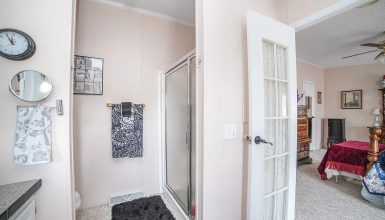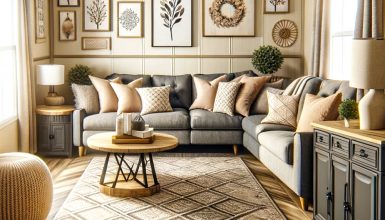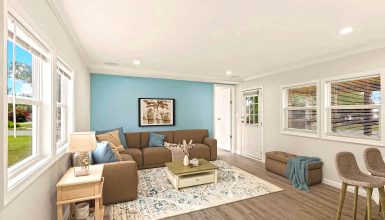Replacing ceiling panels in manufactured homes is more common than you might think. Over time, the original panels can show wear and tear from leaks, humidity, or just plain age. If you’re dealing with sagging panels, stains, or cracks, it’s time to refresh. The good news? There are plenty of materials that can transform your ceiling into a feature you’ll love. Let’s dive in!
1. Drywall: The Classic Option
When it comes to ceilings, drywall is a top choice—and for good reason. It’s like a blank canvas that lets you create any look. You can paint, texture, or even install decorative molding for extra flair. Its smooth finish adds a clean, polished vibe to any room, making it ideal for living rooms and bedrooms where aesthetics matter most.
However, drywall could be better. It’s heavier than some other materials, so your ceiling frame must be strong enough to support it. This can add extra steps to the installation process. The good news? There’s a workaround: lightweight drywall. It’s easier to handle and puts less strain on your ceiling structure.
Pro Tip: If you’re DIYing, make sure to secure the panels properly. Even lightweight drywall needs enough support to stay snug and flat.
2. PVC Ceiling Panels: Lightweight and Waterproof
If you’re looking for something practical and low-maintenance, PVC ceiling panels might be your new best friend. These incredibly lightweight panels make installation a breeze, even for beginners. Plus, they’re waterproof, which is a game-changer in areas like kitchens, bathrooms, and laundry rooms where moisture is a constant battle.
Another big win? PVC panels are super easy to clean. A quick wipe-down keeps them looking fresh, which is perfect if your ceiling tends to collect dust or grime. But remember that PVC doesn’t always have the warm, natural look of materials like wood or drywall. It’s more functional than fancy, though you can find some stylish patterns and textures to dress it up.
Pro Tip: Go for textured or patterned PVC panels if you want to add some character to your space. It’s an easy way to balance practicality with personality.
3. Wood Planks or Panels: Rustic Elegance
Wood planks or panels are a great choice if you want your home to feel warm and cozy. They add a rustic charm that works perfectly in dining rooms, living spaces, or as a statement ceiling. They come in many finishes—natural tones, painted styles, or even a distressed look. This makes them super versatile for different home designs.
The best part? Wood has a timeless appeal. It adds natural beauty and a sense of luxury to any room. But keep in mind, it does need some care. You might need to reseal or refinish it occasionally, especially in areas with a lot of moisture. And yes, it can be pricier than other materials, but the beautiful, long-lasting results make it worth every penny.
Pro Tip: Choose pre-stained or prefinished wood to save time. It’s ready to install and looks fantastic right away!
4. Vinyl Panels: Affordable and Practical
Vinyl panels are a perfect choice for anyone working with a budget. They’re lightweight and super easy to install, making them a favorite for DIYers. Once installed, they require almost no maintenance, which means you can enjoy a fresh-looking ceiling without extra effort.
Vinyl might be a more stylish option, but you can still make it work! While the design options can be limited, adding some trim or molding can take your ceiling from simple to stunning.
Pro Tip: Use vinyl panels in laundry rooms, garages, or budget-conscious makeovers. Adding crown molding around the edges can give your ceiling a more polished look without breaking the bank.
5. Metal Ceiling Tiles: Vintage Charm
Metal ceiling tiles are a showstopper if you aim to wow your guests. They’re durable and fire-resistant, bringing your home a vintage or industrial flair. These tiles can turn any ceiling into a statement piece, especially if you choose a classic pressed tin design or a shiny, modern finish.
However, metal tiles are heavier than other materials and might need extra support during installation. They’re also a little pricier, but their durability and style make them a worthwhile investment. These tiles work best in dining rooms, kitchens, or entryways where you want to make a lasting impression.
Pro Tip: Go with pressed tin tiles with intricate designs for a timeless look. They pair beautifully with traditional decor and add a touch of elegance to any room.
6. Acoustic Tiles: Quiet and Functional
Acoustic tiles are a fantastic option to reduce noise while upgrading your ceiling. These tiles are lightweight, easy to install, and perfect for spaces where sound control matters—like bedrooms, offices, or media rooms. Their ability to absorb sound makes them ideal for creating a calm, quiet environment.
But, like any material, they have drawbacks. Over time, acoustic tiles can turn yellow or discolor, especially in spaces with moisture or sunlight. Plus, they’re only the most stylish choice if you get creative.
Pro Tip: Give your tiles a fresh coat of paint to brighten them up and match your decor. It’s an easy way to keep them looking sharp!
7. Shiplap or Beadboard: Farmhouse Flair
Shiplap and beadboard are timeless choices that bring your home a cozy, farmhouse feel. They work beautifully in coastal, cottage, or rustic designs, and their clean lines make any space feel more structured. You can leave them natural for a classic wood look or paint them to match your style.
Installing shiplap or beadboard does take a bit of patience, especially if you’re doing it yourself. But the result is worth the effort—it adds charm and texture that instantly transforms a room.
Pro Tip: Paint shiplap or beadboard in light, airy colors to make the space feel bigger and brighter. This trick works especially well in smaller rooms.
8. Plywood Panels: Cost-Effective and Flexible
If you’re looking for a budget-friendly ceiling solution, plywood panels are excellent. They’re easy to install, making them perfect for DIYers, and their versatility lets you customize them to fit your space. Sand them for a smooth finish, or leave them raw for a more rustic look.
The downside? Plywood can sometimes feel unfinished if you don’t add some extra touches. But with some creativity, you can make it look polished and professional.
Pro Tip: Sand and paint your plywood panels for a sleek, modern look. Add trim or molding for extra flair without spending a fortune.
9. Fabric Panels: Soft and Stylish
Fabric panels are a unique way to make your ceiling stand out. They bring a soft, cozy vibe perfect for bedrooms or creative spaces. With endless patterns, colors, and textures to choose from, the fabric gives you a chance to personalize your ceiling in a way other materials can’t.
However, fabric panels are less durable than other options. They can attract dust and may need more upkeep. But if you love switching up your style, they’re a fantastic choice.
Pro Tip: Use removable fabric for your panels. It makes updates a breeze and lets you refresh your ceiling whenever you like it.
10. Fiberglass Reinforced Panels (FRP): Built to Last
Fiberglass Reinforced Panels, or FRP, are designed for durability. They’re adamant, water-resistant, and built to handle wear and tear. This makes them great for practical spaces like garages, laundry rooms, or basements.
The downside is their industrial look, which might only suit some styles. But don’t let that stop you! You can add decorative borders or pair them with other materials to make them more visually appealing.
Pro Tip: Use trim or molding to soften the edges and make FRP look less industrial. It’s an easy way to blend durability with style.


























